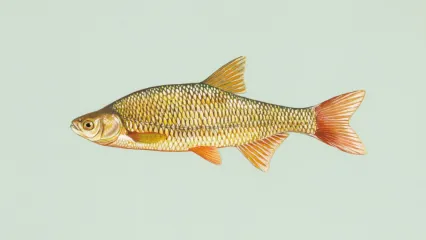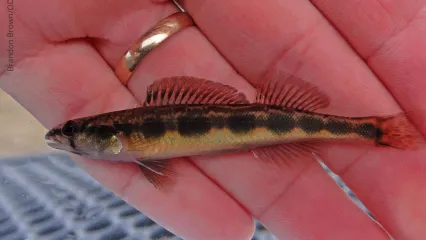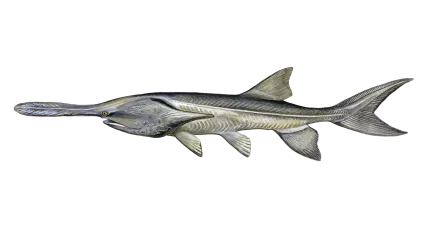
Description
The leopard darter is a streamlined fish in the perch family with adults reaching an average length of three inches. It has several large and distinctive dark spots on the sides of its body. Compared to other closely related species, these spots often have a “cleaner” appearance, especially on the edges. Its overall coloration can range from an olive color to more of a yellowish tone. The dorsal region of the leopard darter is variable but usually has markings resembling bars or saddles.
Leopard darters are rarely found in large densities, even in high-quality habitats. The primary cause of negative impacts to leopard darters is the construction of reservoirs and impoundments. Smaller barriers such as road crossings also may have been constructed in such ways as to hinder fish passage. Such structures have altered seasonal flows and created impasses that have impeded gene flow between populations both up and downstream. Other activities that have attributed to habitat degradation include nutrients in runoff from agricultural operations, logging activity, and gravel mining. Multiple agencies assist the U.S. Fish and Wildlife Service with annual surveys to monitor leopard darter populations including the Wildlife Department’s Wildlife Diversity Program, the U.S. Forest Service, and the Arkansas Game and Fish Commission. Long-established survey sites in Oklahoma and Arkansas are divided into two groups, with twenty permanent sites being surveyed each year, and an additional 100 sites being surveyed on a 3-4 year rotational basis. The results of these efforts allow the USFWS to monitor trends and detect increases or decreases in the relative abundance of leopard darters throughout the Little River watershed. The Wildlife Diversity Program has funded two research and recovery projects for the leopard darter with Oklahoma State University through ESA Section 6 funding. These include a project conducted in 1986 to research the reproductive ecology of the darter, followed by a 1993-1996 mark-recapture study to determine movement, population abundance, and survival rates. As of 2017, USFWS biologists are planning to translocate juvenile fish from one population to another in an attempt to increase genetic diversity.
Size
Rarely exceeds 3 inches in length.
Habitat
In Oklahoma, the leopard darter occurs only in the clear, gravel-bottomed streams of the Mountain Fork, Glover, and Upper Little rivers. Rarely found in smaller streams, leopard darters are usually found in intermediate to large streams. These fish have a tendency to select quieter pools with substrates composed of mixed larger and smaller cobble and boulders. During the late summer months, leopard darters may retreat to the deeper portions of a stream to avoid high water temperatures in shallow water.
Life Cycle
Leopard darters are fairly short-lived, having an average lifespan of two years. Adults usually spawn in riffle habitat (shallow areas with a high current) between March and April, though individuals may spawn intermittently and not reproduce every year. Leopard darters are predatory; both young and adult fish feed on aquatic insects and small crustaceans. While most darters swim along the bottom of the stream, leopard darters often swim one to two feet above the substrate.



